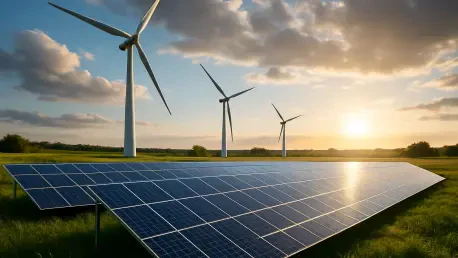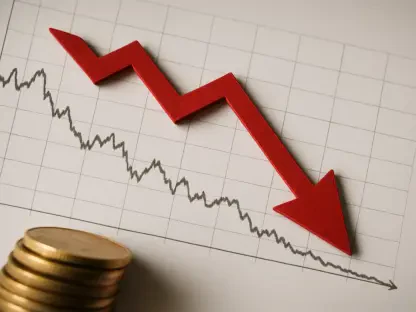The United States finds itself at a critical juncture in its energy landscape, grappling with an unprecedented surge in electricity demand driven by rapid digitization, the rise of artificial intelligence, and the electrification of key sectors such as transportation and industrial operations. This escalating need for power presents a golden opportunity for clean energy to emerge as a cornerstone of the nation’s energy mix, offering both environmental benefits and economic profitability. Yet, the path forward is fraught with complexity as recent policy shifts lean toward deregulation and a renewed emphasis on fossil fuels, casting doubt on the future of sustainable investments. Drawing on expert insights shared during New York Climate Week, particularly from Javier Rodríguez Soler, Global Head of Sustainability at BBVA, this exploration delves into whether clean energy can truly prosper under such challenging conditions. The discussion spans rising energy demands, policy impacts, global decarbonization trends, and the pivotal role of financial support in shaping a sustainable future.
Surging Energy Needs and Clean Energy Potential
The relentless growth in energy consumption across the U.S. is reshaping the national conversation around power generation and sustainability. Fueled by technological advancements like artificial intelligence and the widespread adoption of electric vehicles, this structural increase in demand has positioned clean energy as a vital solution to meet both current and future needs. Javier Rodríguez Soler, speaking at New York Climate Week, emphasized that renewable energy sources are not merely an environmental imperative but also a financially sound choice, offering robust returns on investment. Recent regulatory incentives have further bolstered the appeal of low-carbon technologies, creating a framework where sustainability aligns seamlessly with the country’s aspirations for energy independence. This dynamic suggests that clean energy could play a transformative role in addressing the nation’s escalating power requirements, provided the momentum is sustained amid fluctuating political priorities.
Beyond the immediate demand, the opportunity for clean energy to redefine the U.S. energy sector is becoming increasingly evident. The economic viability of renewables, such as solar and wind, stands out even as traditional energy sources remain dominant in certain policy circles. Rodríguez Soler highlighted that the competitive edge of these technologies lies in their decreasing costs and scalability, making them attractive to investors seeking long-term gains. This shift is particularly significant in a market driven by the need for reliable and expansive energy capacity to support industrial growth and digital infrastructure. While challenges persist in integrating these solutions into a grid historically reliant on fossil fuels, the potential for clean energy to contribute to national energy security cannot be overlooked. The focus now must turn to leveraging these opportunities to build a resilient and forward-looking energy ecosystem that prioritizes sustainability without sacrificing economic stability.
Policy Dynamics and the Resilience of Renewables
Navigating the current policy environment in the U.S. reveals a complex interplay between deregulation and the enduring appeal of clean energy investments. Despite a noticeable tilt toward fossil fuel support in national strategies, renewable technologies continue to demonstrate remarkable resilience, driven by their cost-effectiveness and alignment with long-term energy goals. Rodríguez Soler noted during his discussions at New York Climate Week that the economic returns from low-carbon solutions remain compelling, even in a regulatory landscape that appears less supportive. This persistence underscores a critical opportunity to expand sustainable energy capacity, proving that profitability need not be at odds with environmental responsibility. The challenge lies in maintaining this trajectory amid policy uncertainties that could potentially derail progress if not addressed with strategic foresight.
Further examination of the policy landscape shows that while deregulation poses hurdles, it has not entirely dimmed the prospects for clean energy. The inherent advantages of renewables, such as reduced operational costs and growing public demand for greener alternatives, provide a buffer against unfavorable legislative shifts. Insights from industry leaders suggest that the sector’s growth is also fueled by state-level initiatives and private sector commitments that often bypass federal hesitations. Rodríguez Soler pointed out that these localized efforts are crucial in sustaining momentum, as they create micro-environments where clean energy can thrive independently of broader national policies. This patchwork of support illustrates a broader truth: the transition to a sustainable energy future in the U.S. may depend as much on grassroots and corporate action as on overarching governmental directives, highlighting the need for a multifaceted approach to policy engagement.
Global Lessons in Decarbonization Efforts
Turning to the international stage, the global energy transition offers valuable insights through diverse regional strategies tailored to local conditions and resources. In Europe, the emphasis lies on decarbonizing heavy industries such as steel and cement, with innovations like green hydrogen and carbon capture technologies leading the charge. Meanwhile, Latin America focuses on nature-based solutions, including reforestation and sustainable agricultural practices, to combat carbon emissions. Rodríguez Soler, during his New York Climate Week engagements, stressed that these varied approaches reflect the necessity of customized pathways rather than a one-size-fits-all model for sustainability. For the U.S., these global examples provide a blueprint for integrating diverse strategies into its own energy framework, potentially enhancing national efforts by adopting proven practices from abroad.
The diversity in global decarbonization efforts also highlights the importance of adaptability in addressing climate challenges. Europe’s technological focus contrasts with Latin America’s ecological priorities, yet both regions share the common goal of reducing carbon footprints through regionally relevant means. This adaptability could serve as a guiding principle for U.S. policymakers and industry leaders seeking to balance energy demands with environmental goals. Rodríguez Soler underscored that learning from these international models could help the U.S. refine its approach, particularly in areas like industrial emissions where progress has lagged. By fostering cross-regional dialogue and collaboration, there is potential to accelerate the adoption of best practices, ensuring that clean energy initiatives are both effective and contextually appropriate. This global perspective enriches the domestic conversation, offering a broader lens through which to view the possibilities for sustainable transformation.
Financial Support as a Catalyst for Change
Financial institutions stand at the forefront of the clean energy revolution, playing an indispensable role in enabling the transition to a low-carbon economy. BBVA, as articulated by Rodríguez Soler at New York Climate Week, exemplifies this commitment through significant investments and advisory services aimed at scaling sustainable projects. Having already directed €304 billion into sustainable business, with a target of €700 billion by 2029, the bank demonstrates how capital can drive meaningful change when aligned with economic viability. This approach ensures that sustainability efforts are not only environmentally impactful but also feasible for businesses and households. The emphasis on profitability as a cornerstone of transformation highlights a pragmatic strategy that could inspire other financial entities to prioritize green investments as a core component of their portfolios.
Moreover, the role of financial support extends beyond mere funding to encompass strategic guidance and partnership-building. Rodríguez Soler emphasized that banks must act as facilitators, helping clients navigate the complexities of adopting clean energy solutions while maintaining fiscal health. This dual focus on environmental and economic outcomes is evident in BBVA’s efforts to integrate sustainability into corporate value chains, ensuring that green initiatives are both scalable and sustainable over the long term. Such comprehensive support is crucial in a U.S. context where policy fluctuations can create uncertainty for investors. By providing stability through financing and expertise, financial institutions can bridge gaps left by regulatory inconsistencies, fostering an environment where clean energy projects can flourish. This model of active engagement sets a precedent for how the financial sector can lead in shaping a greener future.
Forging Ahead Through Strategic Alliances
The journey toward a sustainable energy future in the U.S. hinges on robust collaboration across sectors, uniting financial institutions, corporations, and policymakers in a shared mission. Discussions led by Rodríguez Soler at New York Climate Week underscored a consensus that strategic partnerships are vital for overcoming policy barriers and amplifying the impact of clean energy initiatives. These alliances enable the pooling of resources, knowledge, and influence, creating a synergistic effect that can accelerate the deployment of low-carbon technologies. The involvement of entities like BBVA in global coalitions further illustrates the trend of embedding environmental and social governance principles into corporate practices, fostering transparency and inclusivity as cornerstones of progress. This collaborative spirit is essential for navigating the complexities of the current energy landscape.
Looking deeper, the value of these partnerships lies in their ability to address multifaceted challenges through collective action. Whether it’s aligning regulatory frameworks with sustainability goals or scaling innovative technologies, the combined efforts of diverse stakeholders can yield solutions that are greater than the sum of their parts. Rodríguez Soler’s insights suggest that such collaborations also serve as platforms for dialogue, allowing for the exchange of ideas and strategies that can be adapted to local contexts. In the U.S., where policy headwinds often slow progress, these alliances offer a counterbalance, driving momentum through shared commitment and mutual accountability. As the energy sector continues to evolve, strengthening these connections will be paramount in ensuring that clean energy not only survives but thrives, paving the way for a resilient and sustainable energy ecosystem that benefits all.









